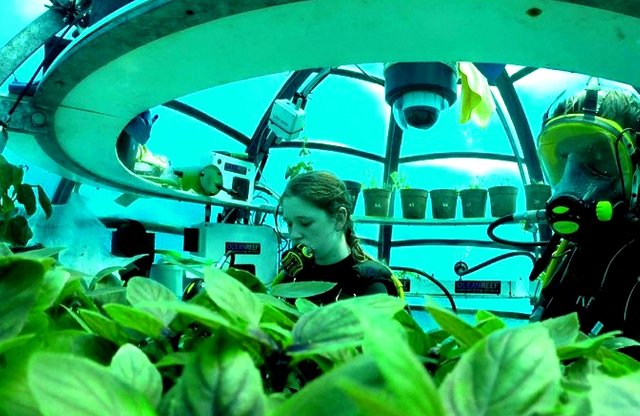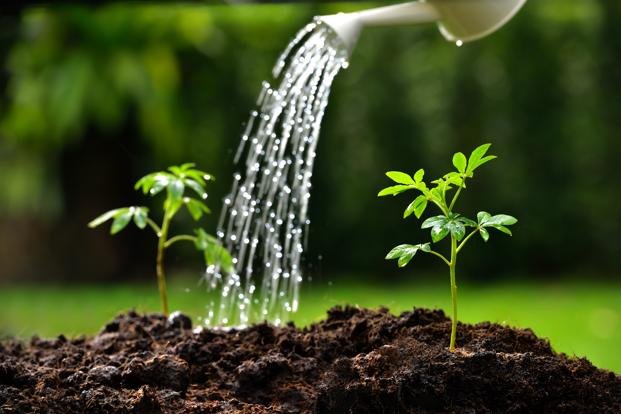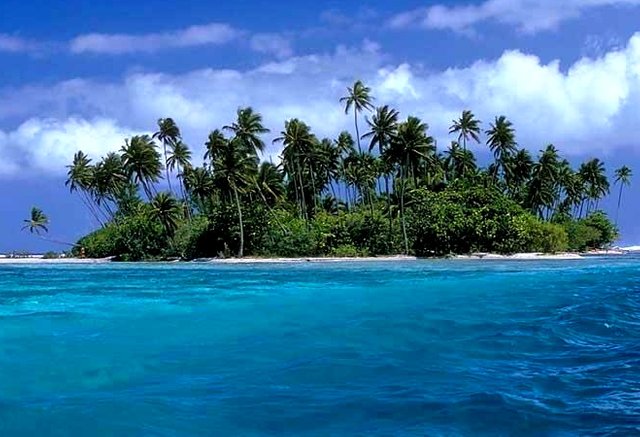What is Impact of Sea Water on Crops?
Hi all my best friend .... How are you all in Steemit? I wish all of you on good health and keep enjoy.
How important is water for the life of agricultural crops. Without water the plant will not grow properl, can wilt and even die from drought. Conversely, excess water or flooding can also destroy all the plants, let alone flood from the sea.
On this occasion, I raised the issue "Positive and Negative Impacts of Salt Water / Sea Water on Agricultural Land."
When I visited farmland owned by farmers in Aceh, I was interested in seeing rice crops and other plants that thrive in the hills far from river water. For a moment I thought how they irrigate the rice field if it happened dry, apparently farmers there irrigate their fields by way of pumping the river water that is under the hills by using diesel engines that are poured over the hills and put into the patches of rice fields using pipe. So, the way farmers irrigate their rice fields in contrast when compared with farmers in lowland land, especially land close to the sea.
Rice can certainly grow either on land that is near the sea or a lot of land containing salt water, even the leaves and stems are green and the growth is very fertil, but the effect on the fruit becomes empt.
Is not the purpose of planting rice to bear fruit full of content? Based on the development of an increasingly advanced era, it is necessary appropriate technology to solve the proble.
Water is a very important natural resource for the life of beings on earth. Water sources are obtained from soil, springs, rivers, lakes and seawate.
The source of water in the earth comes from a cycle of water absorbed by the sun resulting in evaporation, on land and at sea. Then the water rises and converges into clouds, then clouds undergo condensation and cooling will form water dots and eventually into rain.
Furthermore, the water that has been absorbed by the sun becomes rainwater and falls to some earth seep into the soil into groundwater and springs, partly flowing through channels called river water, lake / swamp and partly back to the sea.
Fresh water is water that does not contain many salt solutions and mineral solutions in it. Fresh water is usually from wells, lakes, rivers and snow. Fresh water is also safe to serve as drinking water for living creatures and for other needs such as daily necessities for mopping, washing, watering plants and other.
Saltwater is water commonly called Ocean Water and the ocean is composed of many sodium chloride salts (NaCl) so the water tastes salty and contains salt. So this water can not be used as the main beverage ingredients consumed by humans.
But this salt water has many functions and benefits for humans, one of which is making salt and is used for flavor ingredients in food. In addition, other functions and benefits for plants and animals, even very many plants and animals that live in saltwater.
Chemical Content In Salt Water
Sea or salt water contains 3.5 % salt and contains calcium, magnesium, sodium, sulfate and potassium. In addition, in seawater there are also many other contents such as dissolved gases, organic materials and insoluble particle.
Sources of salt in the sea come from three things: volcanic gases, weathering of land on the ground, and the circulation of hydrothermal vents in the deep ocean.
Sea water stores a lot of salts contained in salty, so it is beneficial to the health and growth of plants, among others, Chloride 55 %, Magnesium 4 %, Sulfate 8 %, Sodium 31 %, Potassium 1 %, Calcium 1 % And other content less than 1 % of the blorak acid, bromide, bicarbonate fluoride and strontium. Each of the above ingredients can all be beneficial to living things.
The main element of sea water for plant growth
Various mineral elements in seawater are very rich in nutrient needed for growth of plants, animals and humans at a certain level.
Minerals contained in seawater have the potential to be organic fertilizer making materials that can produce healthier foods at a lower cost.
A farmer in the Netherlands "Marc Van Rijsselberghe" experiments on cultivating vegetables using a mixture of seawater and fresh water to grow healthy and delicious organic vegetables. Source
Marc Van Rijsselberghe began experiments on cultivated plants such as carrots, cabbage, onions and beets. But "Marc" found that well-grown crops were potato tubers than other types of vegetables in a combination of seawate.
The main nutrients for plant growth are Nitrogen (N as in NO3-nitrate, NO2-nitrite, Ammonia NH4 +), Phosphorus (P as PO43-phosphate) and potassium (K) followed by Sulfur (S), Magnesium (Mg) and Calcium (Ca). Source
Iron (Fe) is an important component of enzymes and is available in the soil, but not in seawater (0.0034ppm). This makes iron (Fe) an important nutrient for plankton growth.
Thus, coarse salt in seawater is potent for plant fertilizer as an ingredient to improve the content of vitamins and nutrients of food cultivated
Positive impact of sea water utilization a source of plant nutrients
A number of research results indicate that Na is important for non-halohytic plants such as rice (Hasegawa et al 1990; Song and Fujiama 1998), tomatoes (Besford 1978; Song and Fujiama 1996) and beet sugar (Haneklaus et al 1998). This element is very important especially in osmo-regulation. Source
The high salinity of seawater is caused by high concentrations of Chlorite and Sodium. In addition, sulfate, magnesium (Mg), calcium (Ca) and potassium (K) also present in considerably
higher concentrations than other elements.
The high nutrient content in the sea water is needed plant elements Mg, Ca and K provide clues that seawater can be one alternative source of nutrients for plants.
The challenge faced is effort to utilize these nutrients by lowering the content of Na and Cl to a level that is not harmful to plant. Besides, Na element can also be used as nutrient for certain types of plants.
The development of sea-based crops has been largely done in halophytic plants grown near the coast, due to lack of fresh water or fresh water.
Various research results have provided great opportunities on the cultivation of halophytic plants, especially those that produce foliage for feed and seeds using seawater.
O'Leary et al (1985) states that halophytic plants that are watered by sea water have high nutrients and easily digested. Seeds of halophytic plants do not accumulate salt in excess of glycophytic plants and contain high protein and oil content even though irrigated with high saline sea water. Source
Plants such as wheat, rice and corn turned out to be more tolerant of high salinity than oil-producing grains such as peanuts and sunflowers.
Rains and Goyal (2003) suggest that both transport membranes at both root and translocation within the plant are main characteristics of high tolerant salinity crops. Source
Negative influence in utilization of sea water on plants
The main constraint in utilization of nutrients from sea water is a negative impact on soil and plants due to high salinity, so that the aggregate of soil become broken, small minerals and organic particles clog soil pore so that flow of groundwater will decrease.
As a result of Na dispersion in clay and organic matter reduces soil aggregation, permeability to air and water, germination and root growth. Soil dispersion occurs when Na can exchange exceeds 10-20% CEC (Tisdale et al, 1993). Source
The high concentration of (Na) in soil against plant growth can be distinguished on three :
- Inadequate water absorption due to low osmotic potentia.
- Metabolic disturbance caused by high concentration of Na in plant tissue.
- Inhibition of other cation absorption.
According to (Bradley and Morris 1991), Plants divided into halophytic and glycophytic two. Halophytic is a plant that is tolerant of high salinity because of its ability to absorb water by maintaining a high osmotic potential through the accumulation of inorganic ions. In contrast, the plants that classified as glycophytic sensitive to high salinity. Source
Conclusion
Chemically, plants need elements of potassium, macro Nitrogen and Phospat, to produce fertilizer Kcl, Phospat and Urea that can be used as fertilizer by farmers.
Salt (NaCl/Sodium Chloride) is excellent for plant fertilizers such as rice, cocoa, coconut, or other crops. Even plants will flourish like using conventional fertilizers in general.
Nutrient elements in seawater are very high, but cultivating crops need to identify salinity-tolerant plant species, due to potential constraints to be faced by high salinity.
Due to the high salinity, it is advisable to dissolve sea water before it is applied to plant. To meet needs of plant nutrients from sea water, should cultivated crop in agricultural areas near coast.
Source

Best Regards @azirgraff
Translation
Betapa pentingnya air bagi kehidupan tanaman pertanian. Tanpa air tanaman tidak akan tumbuhan dengan baik, bisa layu bahkan mati akibat kekeringan. Sebaliknya, kelebihan air atau kebanjiran bisa juga memusnahkan semua tanaman, apalagi banjir dari laut.
Pada kesempatan ini, saya mengangkat masalah “Dampak Positif dan Negatif Air Asin/Air Laut Terhadap Lahan Pertanian.”
Ketika saya berkunjung ke lahan pertanian milik petani di Aceh, saya tertarik melihat tanaman padi dan tanaman lainnya yang tumbuh subur diperbukitan yang jauh dari air sungai. Sejenak saya berpikir bagaimana mereka mengairi sawah sekiranya terjadi kemarau, rupanya petani di sana mengairi sawahnya dengan cara memompah air sungai yang ada di bawah perbukitan dengan mengunakan mesin diesel yang dialirkan keatas perbukitan dan dimasukkan ke petak-petak sawah menggunakan pipa. Jadi, cara petani dalam mengairi sawahnya bertolak belakang jika di bandingkan dengan petani yang ada di lahan dataran rendah apalagi lahannya dekat dengan laut.
Padi tentunya bisa saja tumbuh baik dilahan yang berada di dekat laut atau lahan yang banyak mengandung air asin, bahkan daun dan batangnya hijau serta pertumbuhannya sangat subur, akan tetapi pengaruhnya pada buah menjadi kosong atau hampa.
Bukankah tujuan menanam padi untuk menghasilkan buah yang penuh isi? Berdasarkan perkembangan zaman yang semakin maju, maka perlu teknoklogi tepat guna untuk memecahkan masalah tersebut.
Air merupakan sumber daya alam yang sangat penting untuk kehidupan makhluk di bumi. Sumber air diperoleh dari tanah, mata air, sungai, danau dan air laut.
Sumber air di bumi berasal dari siklus air yang diserap oleh matahari sehingga terjadi penguapan, di darat maupun di laut. Kemudian air naik dan berkumpul menjadi awan, kemudian awan mengalami kondensasi dan pendinginan akan membentuk titik-titik air dan akhirnya menjadi hujan.
Selanjutnya, air yang telah diserap matahari tersebut menjadi air hujan dan jatuh kebumi sebagian meresap kedalam tanah menjadi air tanah dan mata air, sebagian mengalir melalui saluran yang disebut air sungai, danau/rawa dan sebagian lagi kembali ke laut.
Air tawar adalah air yang tidak mengandung banyak larutan garam dan larutan mineral di dalamnya. Air tawar biasanya dari sumur, danau, sungai dan salju. Air tawar juga aman untuk dijadikan sebagai air minuman makhluk hidup dan untuk kebutuhan lainnya seperti kebutuhan sehari-hari untuk mengepel, mencuci, menyiram tanaman dan lain-lain
Air asin adalah air yang biasa disebut Air Samudera dan lautan yang tersusun dari banyak garam natrium chlorida(NaCl) sehingga air terasa asin dan mengandung garam. Sehingga air ini tidak bisa untuk dijadikan sebagai bahan minuman utama yang dikonsumsi oleh manusia.
Namun air asin ini banyak memiliki fungsi dan manfaatnya bagi manusia, salah satunya pembuatan garam dan digunakan untuk bahan penyedap rasa pada makanan. Selain itu, fungsi dan manfaat lainnya adalah untuk tumbuhan-tumbuhan dan hewan, bahkan sangat banyak tumbuhan-tumbuhan dan hewan-hewan yang hidup di air asin.
Kandungan Air Asin
Air laut atau air asin mengandung zat garam sebanyak 3,5 persen dan mengandung kalsium, magnesium, sodium, sulfat dan potasiu. Selain itu, pada air laut juga terdapat banyak kandungan lainnya seperti gas-gas yang terlarut, bahan-bahan organik serta partikel yang tidak larut.
Sumber garam-garaman dilaut berasal dari tiga hal yaitu gas-gas vulkanik, pelapukan batuan didarat, dan sirkulasi lubang-lubang hidrotermal pada laut yang dalam.
Air laut banyak menyimpan kadar garam-garaman yang terdapat pada asinya, sehingga bermanfaat bagi kesehatan dan pertumbuhan tanaman antara lain Klorida 55 %, Magnesium 4 %, Sulfat 8 %, Natrium 31 %, Potasium 1 %, Kalsium 1 & Dan kandungan lain yang nilainya kurang dari 1 % yaitu asam blorak, bromida, bikarbonat florida dan strontium. Masing-masing kandungan diatas semuanya dapat bermanfaat untuk makhluk hidup.
Unsur utama Air Laut yang bermanfaat untuk pertumbuhan tanaman
Berbagai unsur mineral pada air laut sangat kaya kandungan dan nutrisi yang sangat dibutuhkan untuk pertumbuhan tanaman, hewan dan juga manusia pada kadar tertentu.
Mineral yang dikandung dalam air laut sangat berpotensi sebagai bahan pembuatan pupuk pertanian organik sehingga dapat memproduksi makanan lebih sehat dengan biaya murah.
Seorang petani di negara Belanda “Marc Van Rijsselberghe” melakukan percobaan budidaya sayuran menggunakan campuran air laut dan air tawar untuk menanam sayuran organik yang sehat dan lezat. Source
Marc Van Rijsselberghe memulai percobaannya pada tanaman yang dibudidayakan yaitu wortel, kubis, bawang dan bit. Tetapi "Marc" menemukan bahwa tanaman yang tumbuh baik adalah umbi kentang dari pada sayuran jenis lainnya dalam kombinasi air laut
Nutrisi utama untuk pertumbuhan tanaman adalah Nitrogen (N seperti pada nitrat NO3-, NO2- nitrit, Amoniak NH4 +), Fosfor (P sebagai PO43- fosfat) dan kalium (K) diikuti oleh Sulfur (S), Magnesium (Mg) dan Kalsium (Ca). Source
Zat Besi (Fe) merupakan komponen penting dari enzim dan deras tersedia di tanah, tapi tidak di air laut (0.0034ppm). Hal ini membuat zat besi (Fe) merupakan nutrisi penting untuk pertumbuhan plankton.
Jadi, garam kasar pada air laut sangat berpotensi untuk pupuk tanaman sebagai bahan untuk memperbaiki kandungan vitamin dan nutrisi bahan pangan yang dibudidaya.
Dampak positif pemamfaatan air laut sebagai sumber hara tanaman
Sejumlah hasil penelitian menunjukkan bahwa Na sangat penting untuk tanaman non-halohytic seperti padi (Hasegawa et al 1990; Song dan Fujiama 1998), tomat (Besford 1978; Song dan Fujiama 1996) dan gula bit (Haneklaus et al 1998). Unsur ini sangat penting artinya terutama pada osmo-regulation. Sumber
Tingginya salinitas air laut disebabkan oleh konsentrasi Chlorite dan Natrium dalam jumlah yang tinggi. Di samping itu sulfat, magnesium (Mg), calsium (Ca) dan kalium (K) juga terdapat dalam konsentrasi yang cukup tinggi dibandingkan unsur lainnya.
Tingginya kandungan nutrien pada air laut sangat dibutuhkan oleh tanaman yaitu unsur Mg, Ca dan K memberi petunjuk bahwa air laut dapat menjadi salah satu sumber alternatif nutrien bagi tanaman
Tantangan yang dihadapi adalah upaya memanfaatkan unsur-unsur hara tersebut dengan menurunkan kandungan Na dan Cl sampai terutama pada tanaman golongan halophytic yang ditanam dekat pantai, penyebabnya karena kurangnya air bersih atau air tawar.
Berbagai hasil penelitian telah memberikan peluang besar tentang budidaya tanaman halophytic khususnya yang menghasilkan dedaunan untuk pakan dan biji menggunakan air laut.
O’Leary et.al (1985) menyatakan bahwa tanaman halophytic yang diairi air laut memiliki nutrisi yang tinggi serta mudah dicerna. Biji dari tanaman halophytic tidak mengakumulasi garam melebihi dari tanaman glycophytic dan mengandung protein serta kandungan minyak yang tinggi walaupun diairi dengan air laut yang tinggi kadar garamnya. Sumber
Tanaman seperti gandum, padi dan jagung ternyata lebih toleran terhadap salinitas tinggi dibandingkan tanaman biji-bijian penghasil minyak seperti kacang tanah dan bunga matahari.
Rains dan Goyal (2003) menyatakan bahwa membrane transport baik pada akar maupun translokasi didalam tanaman merupakan kharakteristik utama pada tanaman yang toleran terhadap salinitas yang tinggi. Sumber
Pengaruh negatif dalam Pemanfaatan air laut terhadap tanaman
Kendala utama dalam pemanfaatan hara dari air laut adalah berdampak negatif terhadap tanah dan tanaman karena tingginya salinitas atau kadar garam, sehingga agregat tanah menjadi pecah, mineral berukuran kecil dan partikel organik menyumbat pori tanah sehingga aliran air tanah akan berkurang.
Akibat dispersi Na pada liat dan bahan organik mengurangi agregasi tanah, permeabilitas terhadap udara dan air, perkecambahan dan pertumbuhan akar. Dispersi tanah terjadi apabila Na dapat tukar melebihi 10 – 20% KTK (Tisdale et al, 1993). Sumber
Tingginya konsentrasi Na di tanah terhadap pertumbuhan tanaman dapat dibedakan atas tiga yaitu:
- Penyerapan air tidak kuat karena potensi osmotik rendah.
- Terganggunya metabolisme disebabkan tingginya konsentrasi Na pada jaringan tanaman.
- Terhambatnya penyerapan kation lainnya.
Menurut (Bradley dan Morris 1991), Tanaman dibedakan menjadi dua yaitu halophytic dan glycophytic. Halophytic adalah tanaman yang toleran terhadap tingginya salinitas karena kemampuannya menyerap air dengan mempertahankan potensi osmotik yang tinggi melalui akumulasi ion-ion anorganik. Sebaliknya tanaman yang tergolong glycophytic sensitif terhadap salinitas yang tinggi. Sumber
Kesimpulan
Secara kimiawi, tanaman membutuhkan unsur Kalium, makro Nitrogen dan Phospat, untuk melahirkan pupuk Kcl, Phospat dan Urea yang bisa digunakan sebagai pupuk oleh petani.
Garam (NaCl/Natium Chlorida) sangat baik untuk pupuk tanaman seperti padi, coklat, kelapa, atau tanaman lainnya. Bahkan tanaman akan tumbuh subur seperti menggunakan pupuk konvensional pada umumnya.
Unsur hara di air laut sangat tinggi, namun budidaya tanaman perlu mengidentifikasi jenis tanaman yang tahan salinitas, karena kendala potensial untuk dihadapkan pada salinitas tinggi.
Karena salinitas tinggi, disarankan untuk melarutkan air laut sebelum diaplikasikan ke tanaman. Untuk memenuhi kebutuhan nutrisi tanaman dari air laut, sebaiknya dibudidayakan tanaman di daerah pertanian dekat pantai.
Sumber :





fascinating post, almost all place in our area the Water contain salt, even in my well, hehe
Hi @janhuery, You are in Lhokseumawe City with an area of 181.06 Km. High your city 2-24 meters above sea level.
Slide 2 steps, freshwater is on your right side. Neighbors want to wash clothes.
😀😀
the water lot of color brother, you know that. and which one you like it. of course the black and sweet must be your answer. do yo?
even in my cup. they are on fresh, yellow, green, absolutely one more black.
Hi @jenara. If black water is usually Ipomoea aquatica Forsk (kangkung) more suitable. to not be forced to wash clothes.
Water is life... thanks for sharing
You're welcome @emperorrichie
beautiful post. we have to care for the life it's same like you save the world. and the water is both of them because they are 95%. you are very smart to description it all. power full.
Thanks @jenara. Because water there are 2 types of fresh water and salt water, then I need to see the function for plant.
Congratulations @azirgraff! You have completed some achievement on Steemit and have been rewarded with new badge(s) :
Click on any badge to view your own Board of Honor on SteemitBoard.
For more information about SteemitBoard, click here
If you no longer want to receive notifications, reply to this comment with the word
STOP